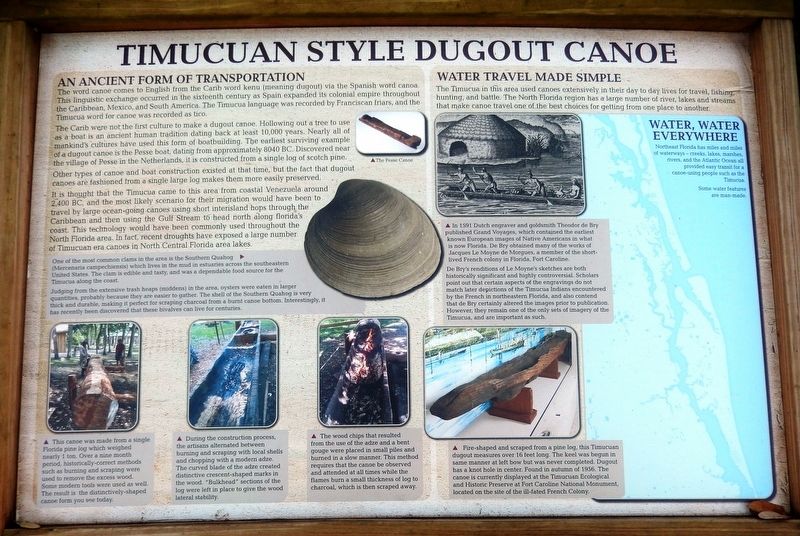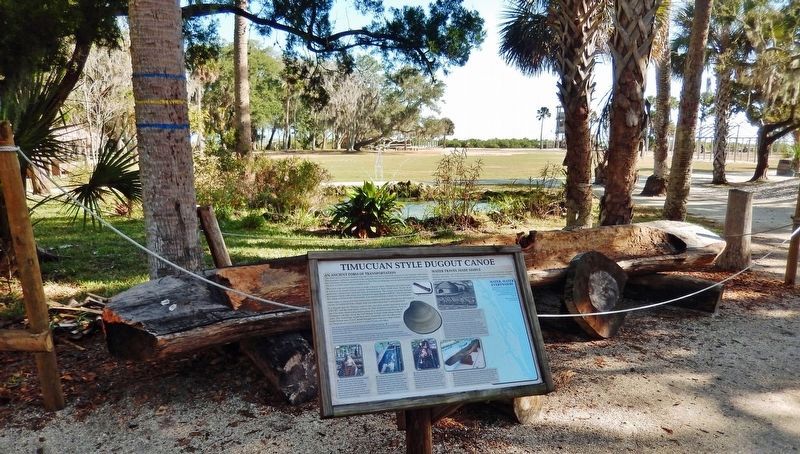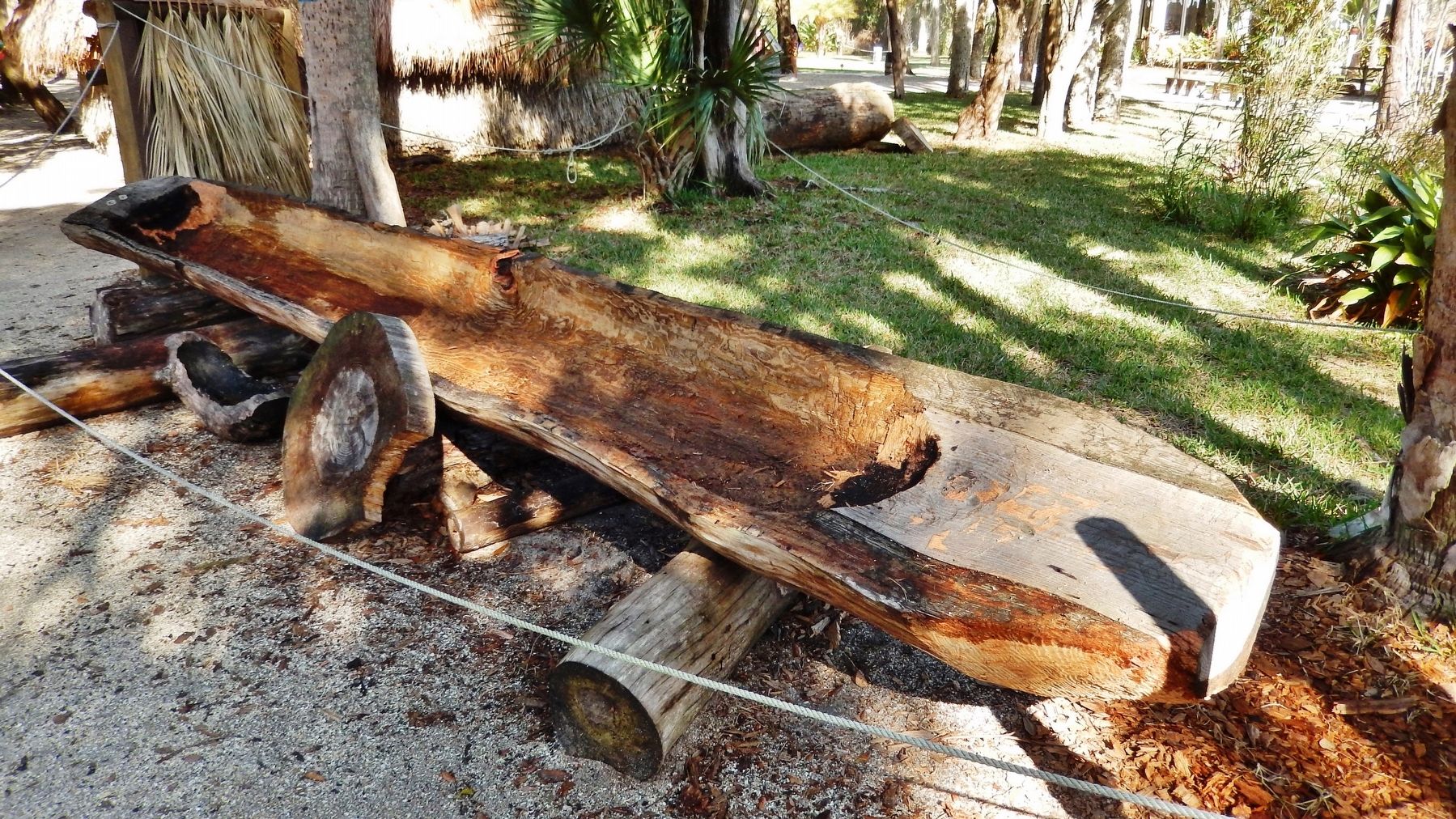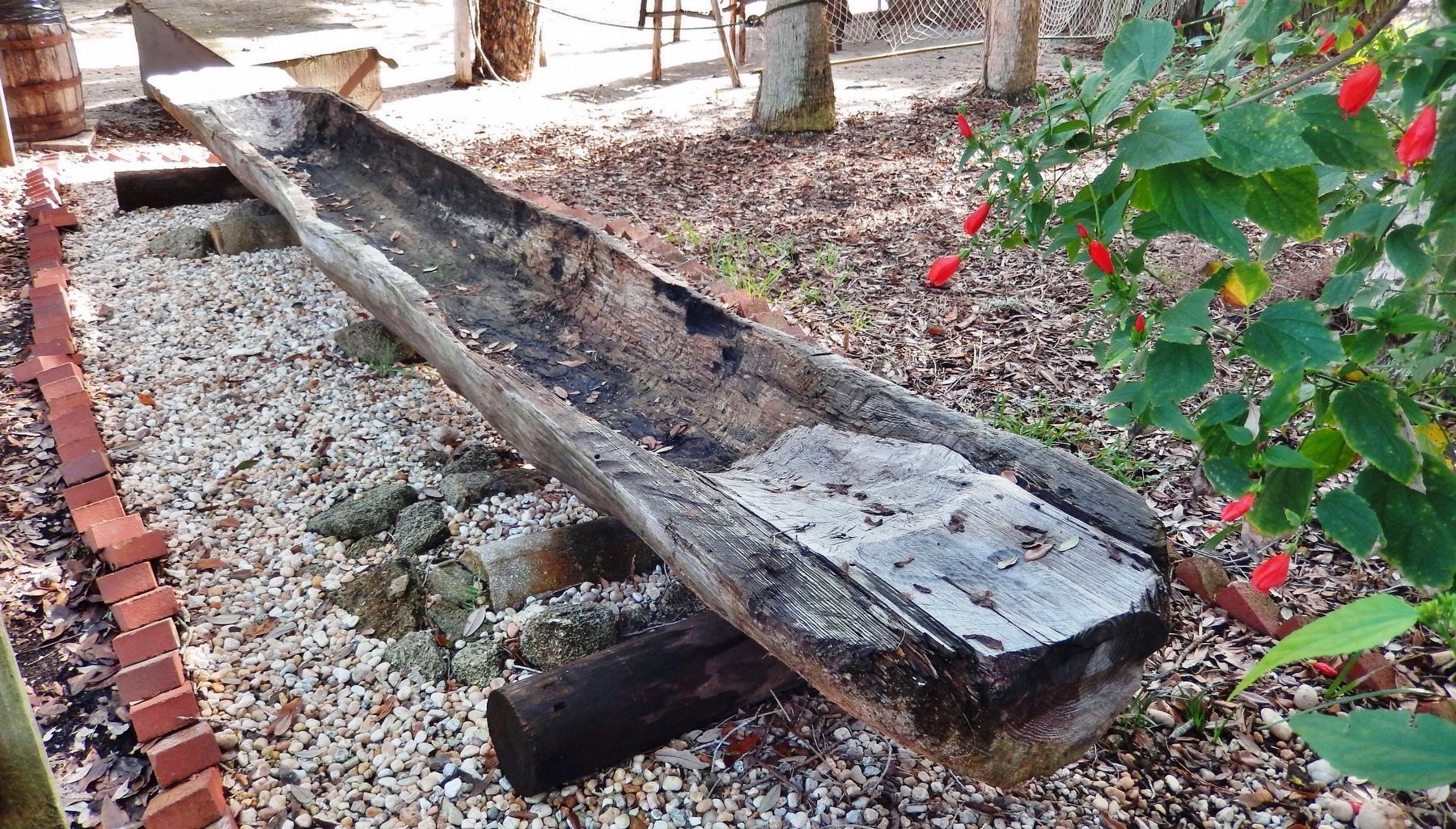St. Augustine in St. Johns County, Florida — The American South (South Atlantic)
Timucuan Style Dugout Canoe
An Ancient Form of Transportation
The word canoe comes to English from the Carib word kenu (meaning dugout) via the Spanish word canoa. This linguistic exchange occurred in the sixteenth century as Spain expanded its colonial empire throughout the Caribbean, Mexico, and South America. The Timucua language was recorded by Franciscan friars, and the Timucua word for canoe was recorded as tico.
The Carib were not the first culture to make a dugout canoe. Hollowing out a tree to use as a boat is an ancient human tradition dating back at least 10,000 years. Nearly all of mankind's cultures have used this form of boatbuilding. The earliest surviving example of a dugout canoe is the Pesse boat, dating from approximately 8040 BC. Discovered near the village of Pesse in the Netherlands, it is constructed from a single log of scotch pine.
Other types of canoe and boat construction existed at that time, but the fact that dugout canoes are fashioned from a single large log makes them more easily preserved.
It is thought that the Timucua came to this area from coastal Venezuela around 2,400 BC, and the most likely scenario for their migration would have been to travel by large ocean-going canoes using short interisland hops through the Caribbean and then using the Gulf Stream to head north along Florida's coast. This technology would have been commonly used throughout the North Florida area. In fact, recent droughts have exposed a large number of Timucuan era canoes in North Central Florida area lakes.
Water Travel Made Simple
The Timucua in this area used canoes extensively in their day to day lives for travel, fishing, hunting, and battle. The North Florida region has a large number of rivers, lakes and streams that make canoe travel one of the best choices for getting from one place to another.
Water, Water Everywhere
Northeast Florida has miles and miles of waterways — creeks, lakes, marshes, rivers, and the Atlantic Ocean all provided easy transit for a canoe-using people such as the Timucua. Some water features are man-made.
[photo captions]
• The Pesse Canoe
• One of the most common clams in the area is the Southern Quahog (Mercenaria campechiensis) which lives in the mud in estuaries across the southeastern United States. The clam is edible and tasty, and was a dependable food source for the Timucua along the coast. Judging from the extensive trash heaps (middens) in the area, oysters were eaten in larger quantities, probably because they are easier to gather. The shell of the Southern Quahog is very thick and durable, making it perfect for scraping charcoal from a burnt canoe bottom. Interestingly,
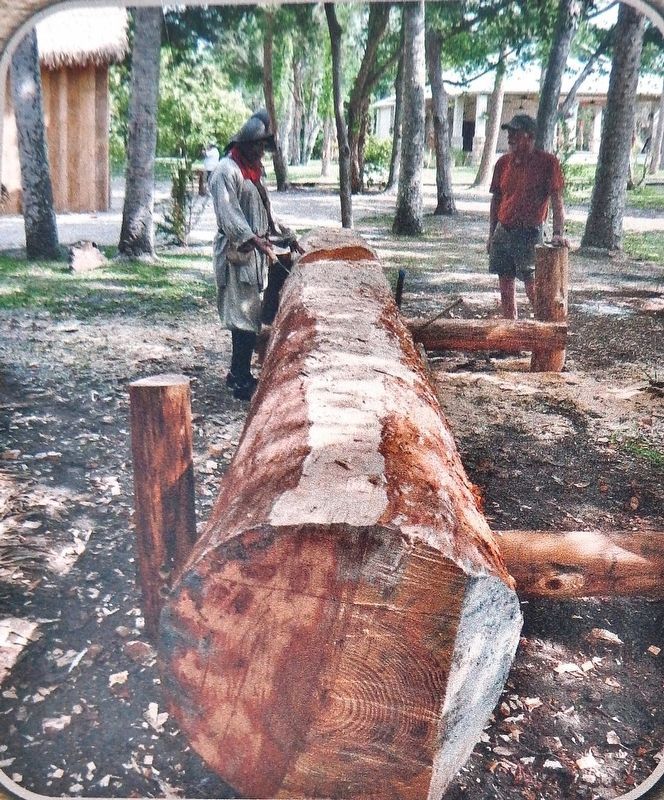
2. Marker detail: Single Log Canoe
This canoe was made from a single Florida pine log which weighed nearly 1 ton. Over a nine-month period, historically correct methods such as burning and scraping were used to remove the excess wood. Some modern tools were used as well. The result is the distinctively shaped canoe form you see today.
Topics. This historical marker is listed in these topic lists: Anthropology & Archaeology • Native Americans • Waterways & Vessels.
Location. 29° 54.41′ N, 81° 18.919′ W. Marker is in St. Augustine, Florida, in St. Johns County. Marker can be reached from Williams Street east of Magnolia Avenue. Marker is located along the interpretive trail in Ponce de León's Fountain of Youth Archaeological Park. Touch for map. Marker is at or near this postal address: 11 Magnolia Avenue, Saint Augustine FL 32084, United States of America. Touch for directions.
Other nearby markers. At least 8 other markers are within walking distance of this marker. Life in the Timucuan Village (a few steps from this marker); Mission Life in Nombre de Dios (a few steps from this marker); Chief Saturiwa (a few steps from this marker); 4,000 BC (a few steps from this marker); The Timucuan Home (a few steps from this marker); Juan Ponce (a few steps from this marker); Tinajónes (a few steps from this marker); 1513 La Florida (within shouting distance of this marker). Touch for a list and map of all markers in St. Augustine.
More about this marker. There are two identical copies of this marker: one on the west side of the Timucuan Village exhibit, and one about 20 yards east on the east side of the exhibit.
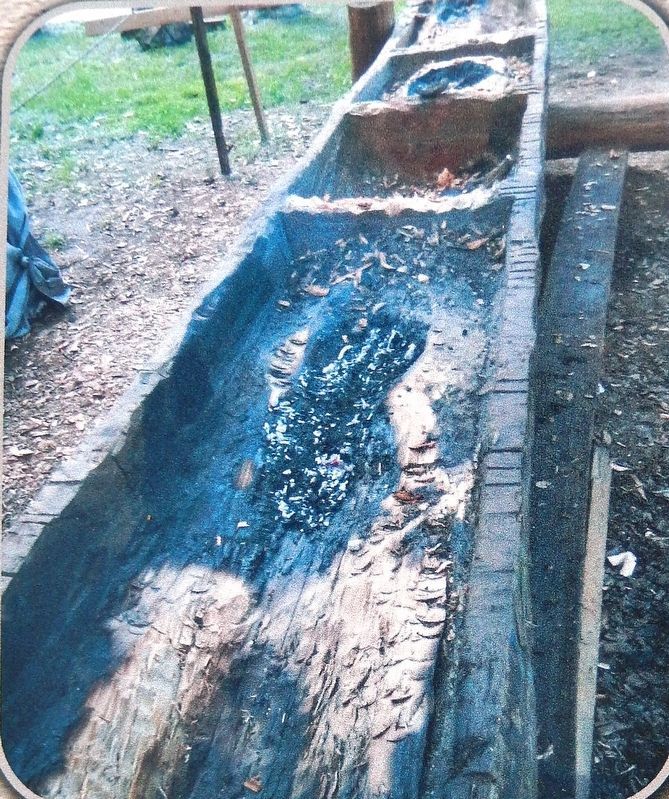
3. Marker detail: Construction Process
During the construction process, the artisans alternated between burning and scraping with local shells and chopping with a modern adze. The curved blade of the adze created distinctive crescent-shaped marks in the wood. "Bulkhead" sections of the log were left in place to give the wood lateral stability.
Related markers. Click here for a list of markers that are related to this marker. Ponce de León's Fountain of Youth Archaeological Park
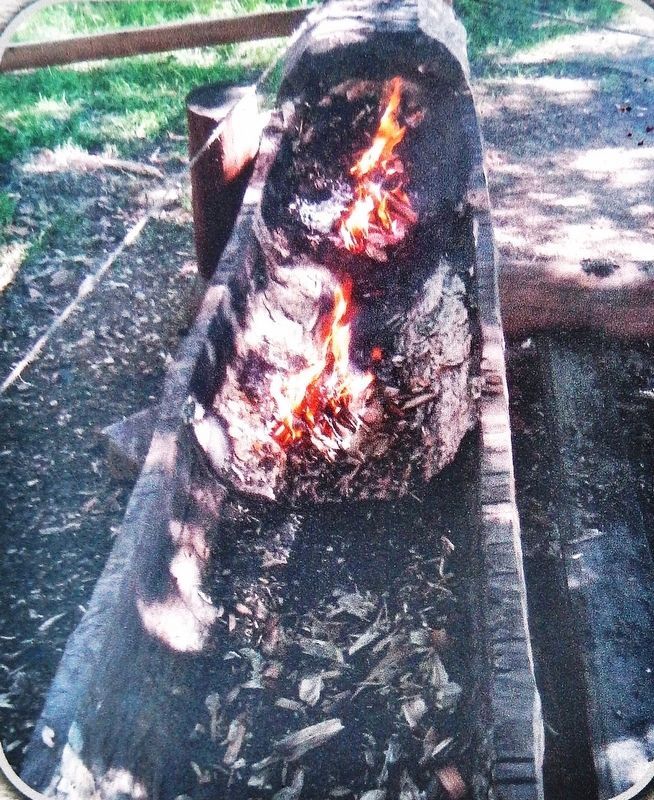
4. Marker detail: Slow Burn to Charcoal
The wood chips that resulted from the use of the adze and a bent gouge were placed in small piles and burned in a slow manner. This method requires that the canoe be observed and attended at all times while the flames burn a small thickness of log to charcoal, which is then scraped away.
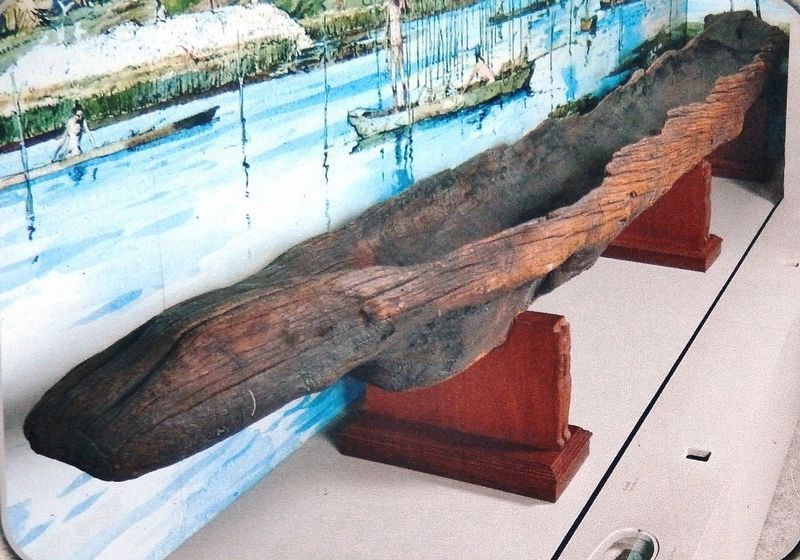
5. Marker detail: Timucuan Dugout Canoe
Fire-shaped and scraped from a pine log, this Timucuan dugout measures over 16 feet long. The keel was begun in same manner at left bow but was never completed. Dugout has a knot hole in center. Found in autumn of 1956. The canoe is currently displayed at the Timucuan Ecological and Historic Preserve at Fort Caroline National Monument, located on the site of the ill-fated French Colony.
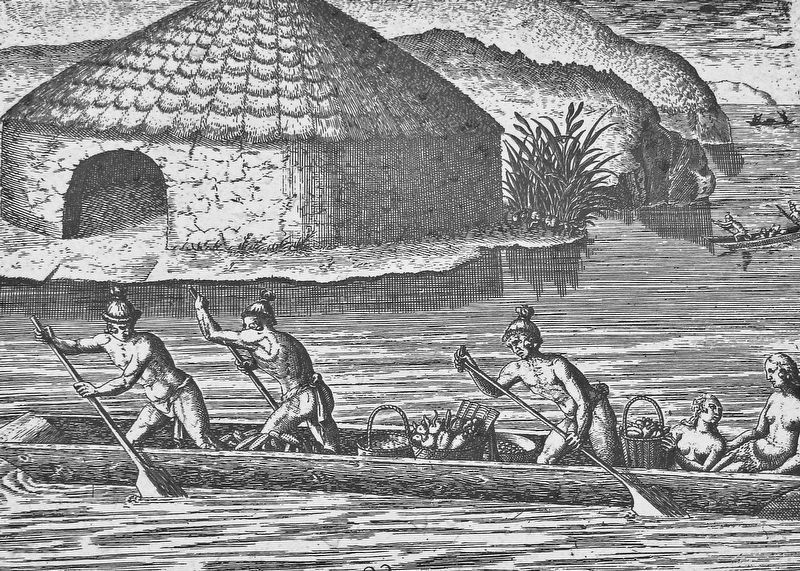
6. Marker detail: Theodor de Bry Engraving from
Jacques Le Moyne de Morgues Sketch
Jacques Le Moyne de Morgues Sketch
In 1591 Dutch engraver and goldsmith Theodor de Bry published Grand Voyages, which contained the earliest known European images of Native Americans in what is now Florida. De Bry obtained many of the works of Jacques Le Moyne de Morgues, a member of the short-lived French colony in Florida, Fort Caroline.
De Bry's renditions of Le Moyne's sketches are both historically significant and highly controversial. Scholars point out that certain aspects of the engravings do not match later depictions of the Timucua Indians encountered by the French in northeastern Florida, and also contend that de Bry certainly altered the images prior to publication. However, they remain one of the only sets of imagery of the Timucua and are important as such.
Credits. This page was last revised on December 29, 2021. It was originally submitted on December 26, 2021, by Cosmos Mariner of Cape Canaveral, Florida. This page has been viewed 481 times since then and 42 times this year. Photos: 1, 2, 3, 4, 5, 6, 7, 8, 9. submitted on December 27, 2021, by Cosmos Mariner of Cape Canaveral, Florida.
